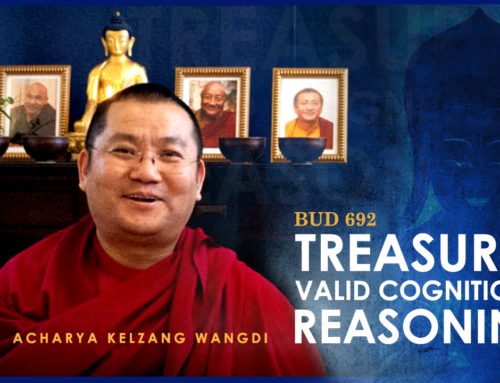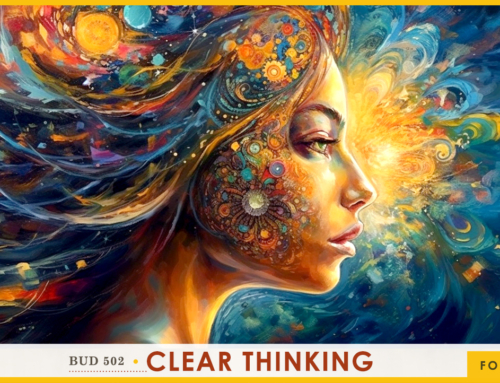Mind & Mental Events
This excerpt is copyrighted material, please do not use or copy without written permission from Nitartha Publications.
This excerpt is from the sourcebook that we use for the Mind & Its World II course. This course completes the Classification of Mind (Lorik) root text, from the tradition of Pramāna or Buddhist epistemology that students began in Mind and Its World I. This course has two main sections. The first provides the practitioner with the tools for delineating conceptual and non- conceptual types of mind in meditation. This teaching is codified as the modes of engagement of mind. The second section investigates mind in terms of the mental factors/events that describe specific functional aspects of mind, as well as determine its virtuous or afflicted states, in order to cultivate the former and relinquish the latter.
If you are curious about this course, learn more here: BUD 510
Mind & Mental Events
Acharya Sherab Gyaltsen
In the explanation of the divisions of mind, which is the large, second part of the outline of the Lorik text, there are three sections: 1) the general teaching about the important divisions of mind, 2) the specific analysis of the essential mode of engagement of mind, and 3) the delineation of the necessary distinction between mind and mental events. We have come to the third section, which distinguishes “mind,” ¹ in the sense of primary mind, from mental events, ² which are the mental processes that accompany the primary mind. Both of these are divisions of “mind,” in the larger sense of that word: both mind and mental events are mental phenomena, not material. The importance of this section of the Lorik is that it encourages us to take a close look at the contents of our mind, at our different types of mental states, and provides a framework, a lens, that will help us bring what we see into clear focus.
Definitions of Primary Mind & Mental Events
The definition of a primary mind is “that which is aware of the essential nature of an object.” The primary mind is that which simply knows the object. There are differing classifications of primary mind in parallel with Buddhism’s various philosophical systems. According to the Vaibhashikas and Suatrantikas, primary mind is divided into the six consciousnesses, five sense consciousnesses and one mental consciousness. According to the Cittamatra tradition, there are eight consciousnesses; they add two mental consciousnesses.
Mental events are what accompany the primary mind. In subsequent chapters, we will consider the classifications of mental events in some detail, but in a broad way we can say that mental events, also called “mental factors” (these two English phrases will be used interchangeably), on the basis of the primary mind observing an object, engage the object from the point of view of its features, such as its functions and so forth. In his classic text Distinguishing the Middle From the Extremes, Maitreya gives a definition of the primary mind as “the consciousness that sees the object.” The primary mind experiences the mere fact or presence of the object. Mental events are described as “what engage the features of the object,” e.g., they discern the function of the object, its pleasantness or unpleasantness, or any of its other features.
Just because something is a mind in the broader sense does not mean that it is mind in the narrower sense of primary mind. Mental events are minds but not primary minds. If there is a primary mind present, there will be its attendant mental factors. If there is no primary mind present, there will not be its attendant mental factors. Although a primary mind and its mental factors have different functions—knowing the object and distinguishing its features, respectively—they all take place within one mental continuum.
Congruency Of Mind & Mental Events
Primary mind and its accompanying mental events are both mind in that they experience an object and are present in the same mental continuum. This point is brought out by saying that a primary mind and its attendant mental factors have five kinds of congruence. These congruencies are presented differently in the two great abhidharma traditions: the tradition of Vasubandhu’s Abhidharmakosha, which our Lorik text follows in this matter, and Asanga’s Abhidharmasamucchaya. According to the Abhidharmakosha presentation, the five are: a) the support, b) object, c) aspect, d) time, and e) substance.
Establishing primary minds and mental events to be congruent
The first way in which a primary mind and its attendant mental events are congruent in is regard to the support. They have the same sense faculty as their support or basis. If we take an eye consciousness as an example of a primary mind, its support will be the eye faculty. Its attendant mental factors will also have the eye faculty as their support.
The second congruence is that of the object, or focus. In the case of an eye consciousness, its object is a form. Its attendant mental factors will also have the same object, a form.
The third congruence is that of the aspect. In the case of an eye consciousness, an aspect of a form will arise to it. For its attendant mental factors also, the same aspect of a form will arise for them. For example, when we look at a brown car, the color brown appears to both the primary mind—the primary mind—and its accompanying mental events.
The fourth congruence is that of time. The arising, abiding, and ceasing of the primary mind, for example, an eye consciousness, occur simultaneously with the arising, abiding, and ceasing of its attendant mental events. Since the primary mind and its attendant mental events arise, abide, and cease together, they cannot have a cause-and-effect relationship, which might be thought to be the case if the primary mind preceded the mental factors.
The fifth congruence is that of substance. Here “substance,” a technical term in this context, refers to the primary mind and its mental events having the same number of moments of the same type. However many moments the primary mind perceives some object, for the same number of moments will its accompanying mental events perceive that object. In a single moment of a primary mind, there will only be one of each of the corresponding mental events. For example, one moment of eye consciousness, a primary mind, can only be accompanied by one of the three types of the mental factor of feeling—pleasant, unpleasant, or neutral.
In Asanga’s Abhidharmasamucchaya, the presentation of the five consciousnesses is slightly different. The congruences of time and substance are the same as in the Kosha. However, in the Samucchaya, the congruences of object and aspect are combined and there are two new ones added: the congruence of essential nature, and that of realm and level.
The congruence of essential nature means that if the primary mind is afflicted by kleshas, then the attendant mental events will also be afflicted. If the primary mind is free of the mental affiction, then the attendant mental event will also be free of affliction.
The fifth congruence in the Abhidharmasammuchaya system, that of realm and level, means that if the primary mind belongs to the desire realm, then the attendant mental events will also belong to the desire realm. If the primary mind belongs to an individual abiding in the form realm, then the attendant mental events will also be of the form realm. In the same way, if the primary mind belongs to a being in the formless realm, the attendant mental factors will be of the formless realm. This means that there will never be, for example, a primary mind belonging to the desire realm with its attendant mental events belonging to the form or formless realms.
Mind itself is extremely vast and has no end or limit. When we talk about the primary mind and its accompanying mental events of feelings, discriminations, and so forth, it may seem that we are making the mind small. But in actuality, the mind is like an ocean. It is one continuum but this continuum has many parts, just as an ocean is one vast body of water, but we can speak about its southern region, its northern area, and so forth. When we talk about what is happening in the mind, we talk about various primary minds; there is a primary mind for the eye consciousness, ear consciousness, nose consciousness, taste consciousness, and body consciousness, each of which is accompanied by its five omnipresent mental factors. At the same time, we may have other mental factors occurring in our mind, such as recollection and so forth. That is why we say that the mind is immeasurable.
We practice meditation to develop the limitless quality of mind—immeasurable qualities of loving kindness, compassion, joy, and equanimity.
We practice meditation to develop the limitless quality of mind. There are the immeasurable qualities of loving kindness, compassion, joy, and equanimity, and we explore these limitless possibilities of mind. Our mind is not restricted the way our physical body is. No matter how much we train physically, we will only be able to jump so far, run so far, live so long, because a body has its limits. But the mind has no such limits. There is no limit to our mind, and so we train to develop it, by meditation for example on its limitless capacity for loving kindness, compassion, joy, and equanimity.





